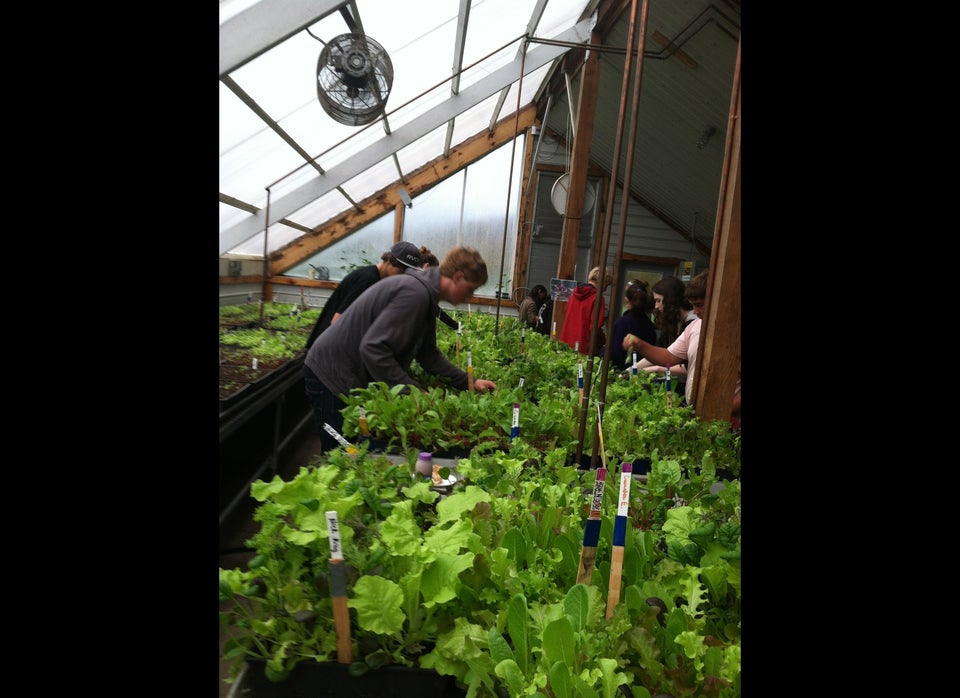 By Anne Watson
By Anne Watson
Physics teacher, Montpelier High School.
I love that every day in the cafeteria I can get a salad grown right here, in Montpelier High School greenhouse. In Part II of our discussion, Tom Sabo and I talked about how our faculty and students use the greenhouse.
Anne Watson: We've got some pretty cool plants -- gourmet lettuce mix, Swiss chard, arugula. What types of plants would you recommend to a school program that's just beginning?
Tom Sabo: I recommend identifying plants that grow well in your region and that can be used by teachers and the school lunch program. For instance, our greenhouse focuses on salad greens. When we are up to speed, students grow all the greens for the salad bars in our school district. There is a 3-4 week growing period for "baby" salad greens. When we are not growing our own lettuce, it usually comes from California, 3,000 miles away. This point is not lost on our students when they calculate the carbon footprint of their meal.
Different plants have different growing needs. For example, salad greens generally like it on the cooler side, and tomatoes like it hot. Growing the two in the same greenhouse can be challenging and will represent compromise for both. There are different varieties that do better in greenhouses and are marketed as such. Greenhouses for salad greens are needed only in the northern parts of the country, and only for certain parts of the year.
AW: How important is the soil?
TS: Very. Fortunately testing and amending the soil is not very expensive and it is very educational. Soil quality will rarely make or break your growing efforts. It will, however, have a substantial impact on plant health and productivity. Determining what the plants need is a great exercise in critical thinking and problem solving.
AW: When you started serving food in the cafeteria grown by students in the biology classes, how did that affect the percentage of students who chose to eat from the salad bar?
TS: When our greens are being served, there is a 65 percent increase in sales of salad bar meals.
AW: I mentioned utilizing the greenhouse in my physics curriculum. How else is it being used by students, teachers and staff in the school?
TS: Our greenhouse, gardens, and the food system as a whole have generated many interesting projects over the years. The solar panel project by your class was certainly one of the most ambitious. Other projects include a greenhouse business plan by the Business class, whole foods curriculum with recipes from the garden by our Health teacher, a community seed library, sub-irrigation system, and root cellar research. These days, through a new educational nonprofit, The Center for Sustainable Systems, we are focusing more on entire lessons and units integrated across the curriculum. Lessons have been created in History, Economics, English, and Spanish to name a few.
AW: What obstacles have you been able to work through with the cafeteria in order to get more produce in our school lunches?
TS: The biggest obstacle has been the labor cost associated with cleaning and preparing whole food. We sell all of our food to the food service at a discounted price to cover the basic material costs of production -- seed, compost, etc. Even if we gave the food for free (which we did in the beginning), it takes people to scrub, peel, and mash, and people cost money. takes one person very little time to open a #10 can, or add water to a box of processed flakes. Having students help prepare a meal as a culminating activity related to a unit of study, and having faculty volunteers assist during the preparation for the Fall Harvest Celebration are a few ways we have addressed this challenge.
AW: Tell us about the Fall Harvest Celebration
TS: This is a school-wide event that features a 100 percent local meal. Vegetables from our gardens provide many of the ingredients, the rest are sourced from area farms. The entire student-body and faculty sit down together for a "slow" meal. Student work that involves the food system is presented and shared. Performances by students and faculty provide entertainment. Some years we include workshops on things ranging from canning and cooking with local foods, to gutting a deer and logging with horses.
AW: What do you see as the next steps towards the sustainability of the food systems at the high school?
TS: Student gardens need to be incorporated into the core curriculum. Communities need to subsidize their lunch programs and the government could provide local food vouchers in place of commodity items to offset the cost of free and reduced lunches.
Anne Watson is a physics teacher at Montpelier High School in Montpelier, Vermont, and a Montpelier City Councilor. She is an alumna of the KSTF Teaching Fellowship.
